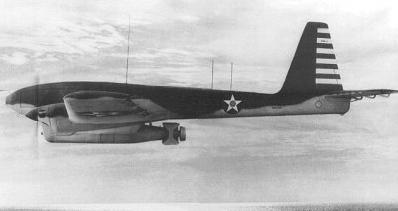![]() The Pacific War Online Encyclopedia
The Pacific War Online Encyclopedia
|
| Previous: TBF Avenger, U.S. Carrier Torpedo Bomber | Table of Contents | Next: Teleokbetoang |

Interstate TDR-1/BQ-4 Assault Drone
|
Crew |
1 for test flights None operationally |
|
|
Dimensions |
48' by 14.6m by |
|
|
Weight |
2700 lb 5900 kg |
|
|
Maximum speed |
140 mph 225 km/h |
|
| 2 Lycoming O-435-2 220 hp (163 kW) 6-cylinder air-cooled horizontally opposed piston engines | ||
|
Range |
425 miles 685 km |
|
|
Armament |
None | |
|
External Stores |
1 2000lb (900 kg) bomb or torpedo |
|
| Production | 189 TDR-1 |
|
The U.S. Navy had experimented with unmanned drones since 1936, but it was not until 1941 that developments in television and radar
provided the key components required for a practical drone. The first
successful television-guided drone flight took place in April 1942 and
the first 100 drones were ordered the same month.
The TDR-1 could carry either a large bomb or torpedo. It was constructed using a low-power engine that required few strategic materials that might compete with conventional aircraft construction. It had a very simple cockpit for test flights, but for operational use the canopy was replaced with a flush fairing and the landing gear were jettisoned after takeoff. The drone had a radar altimeter to automatically maintain altitude until the target was reached, and it was equipped with a television camera that was used to guide the aircraft from a TBF Avenger. The drone had a control radius of at least 30 miles (50 km).
The Navy considered ordering as many as 2000 drones, but the program was given too low priority to quickly overcome the technical challenges involved. Some 46 were expended in combat in the Pacific in 1944, mostly at Bougainville or Cap St. Jacques, with a promising hit rate of 39%, but by then the Navy had already terminated the program. The Army examined a prototype but lost interest before ordering any production drones. The services concluded that the complex electronics would be difficult to maintain in the field and that the system would be easily jammed once the Axis caught on. However, Japanese troops targeted by the weapon were startled by what they believed to be the American use of suicide pilots.
The TDR-1 was the ancestor of both jet-powered
cruise missiles and of modern military drones, but in the absence of
compact and reliable inertial guidance or jamming-resistant control
signal technology, it was simply too far ahead of its time.
 |  |
 |
References
Goebel (2010; accessed 2011-11-25)
Parsh (2005; accessed 2011-11-25)
The Pacific War Online Encyclopedia © 2011, 2014 by Kent G. Budge. Index